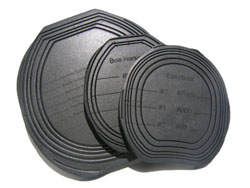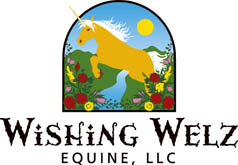
Peripheral Loading and the Pad Effect
by Yvonne Welz ©2007, as published in Issue 27 of The Horse's Hoof Magazine
Before I attended Dr. Robert Bowker’s clinic in January,
2007 (read more on page 20), it never occurred to me that a healthy horse should
have pads placed into their hoof boots. Or that a horse without sore hooves
would benefit from a regimen of boots with pads! What I learned that weekend
changed my mind completely, and I’d like to share that compelling information
with you.
Dr. Bowker, a professor and scientist, has no connection with
any hoof boot companies, so this is not a marketing gimmick! Bowker simply has
some extremely interesting research that we can use to our advantage. Whether
you are rehabilitating a lame horse, trying to create a tough barefoot performance
hoof, or simply trying to maintain your horse’s feet, you need to know
this. If you ever use a boot of any kind on your horse, you need to know this.
And if you ever ride over flat, hard ground with bare hooves, you need to know
this.
What is Peripheral Loading?
Peripheral loading of the hoof occurs when the hoof wall bears
more of the weight. Peripheral loading occurs by degrees; there is more peripheral
loading in a shod hoof standing on a flat surface, versus a bare hoof on a flat
surface. There is more peripheral loading in a bare hoof standing on a flat
surface, versus a bare hoof standing on turf. Peripheral loading is dependent
on both the type of trimming involved (i.e. shoeing, or trimming so that the
hoof wall bears most of the weight) and the surface the hoof is standing upon
(whether or not there is material to pack into the hoof, to relieve the peripheral
load).
Peripheral loading is a negative thing.
Why? Because Bowker’s Dopplar Ultrasound studies have shown
that the greater the peripheral loading, the worse the blood flow throughout
the hoof capsule! Bowker discovered that with less peripheral loading, the greater
the perfusion of blood flow through the hoof. Better blood flow equals healthier
hooves.
The best thing we can do for our horses’ hooves is to try to relieve the peripheral load. How? By transferring some of the load to the sole. Solar loading appears to promote blood flow through the hoof. Think about it—what is natural for the horse? A wild horse lives on undulating terrain, with dirt, grass and weeds. This variable terrain provides a cushion that packs into his hoof as he moves across it. Small rocks and debris provide a constant, but changing, source of stimulation to the sole.

The EasyCare Comfort Pads are an example of a thick foam
pad that provides a significant amount of solar support. I prefer the 12 mm
standard version. These pads are available for any model EasyCare boot, and
could be cut to fit virtually any hoof boot on the market.
Bowker’s studies show that blood perfusion through the foot
is highest when a hoof is on pea gravel and on foam pads, both rating at 90
on his index. A hoof standing on cement rates at 50, while wood rates 55. Lowest
on the chart is a non-weight bearing hoof, at 40.
If you use any type of boot, consider the interior surface of the boot. There
is no way around it—a hard, flat surface will encourage more peripheral
loading while the horse is wearing that boot. But put a thick foam pad inside
that boot, and you’ve suddenly improved your horse’s blood flow to
his hooves! Any horse can benefit from greater perfusion of blood flow, so consider
boots with pads as a useful tool for hoof improvement. In general, if you plan
to ride your horse on a surface that will increase peripheral loading (i.e.,
hard & concussive), you will be much better off using boots and pads during
that ride.
Message of the day: when using hoof boots, don’t leave home without the pads!
Peripheral Loading Chart
Crude index of blood perfusability:
(normal horses)
| Pea rock | 90 |
| Foam pads | 90 |
| Double weight on pea rock |
85-95 |
| Slight exercise | 85 |
| Cement | 50-65 |
| Wood | 55-65 |
| PDN Nerve Block |
40-45 |
| Non-Weighted | 40-50 |
"Foam pads create greater perfusion of foot."—Dr. Robert Bowker
(May 2007)
As published in Issue 27 of The Horse's
Hoof Magazine
©2007 by The Horse's Hoof. All rights reserved. No part of these publications may be reproduced by any means whatsoever without the written permission of the publisher and/or authors. The information contained within these articles is intended for educational purposes only, and not for diagnosing or medicinally prescribing in any way. Readers are cautioned to seek expert advice from a qualified health professional before pursuing any form of treatment on their animals. Opinions expressed herein are those of the authors and do not necessarily reflect those of the publisher.
The Horse's Hoof Website
Home - About Us - Horselover's
Corner - Articles - Barefoot
Performance - Barefoot Stories - Hoof
Gallery - Natural
Horse Care - EPSM
- The Horse's Hoof Clinics - Events
- Trimmers -
Pioneers - Friends
- Classified - Resources
- News - Links
To go shopping or subscribe to our magazine, please click here: The
Horse's Hoof Store
If you don't see a column to the left: To view the frames version of this site, please click here: TheHorsesHoof.com
The Horse's Hoof is a division of:

The Horse's Hoof
P.O. Box 1969
Queen Creek, AZ 85142
Phone (623) 935-1823
Message Phone: 1-623-935-1823
(Leave a message anytime.)
Email: editor @ TheHorsesHoof.com (delete spaces)